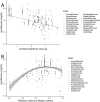Variation in albumin glycation rates in birds suggests resistance to relative hyperglycaemia rather than conformity to the pace of life syndrome hypothesis
- PMID: 40387078
- PMCID: PMC12088674
- DOI: 10.7554/eLife.103205
Variation in albumin glycation rates in birds suggests resistance to relative hyperglycaemia rather than conformity to the pace of life syndrome hypothesis
Abstract
The pace of life syndrome (POLS) hypothesis suggests that organisms' life history and physiological and behavioural traits should co-evolve. In this framework, how glycaemia (i.e. blood glucose levels) and its reaction with proteins and other compounds (i.e. glycation) covary with life history traits remain relatively under-investigated, despite the well-documented consequences of glucose and glycation on ageing, and therefore potentially on life history evolution. Birds are particularly relevant in this context given that they have the highest blood glucose levels within vertebrates and still higher mass-adjusted longevity compared to organisms with similar physiology as mammals. We thus performed a comparative analysis on glucose and albumin glycation rates of 88 bird species from 22 orders in relation to life history traits (body mass, clutch mass, maximum lifespan, and developmental time) and diet. Glucose levels correlated positively with albumin glycation rates in a non-linear fashion, suggesting resistance to glycation in species with higher glucose levels. Plasma glucose levels decreased with increasing body mass, but, contrary to what is predicted in the POLS hypothesis, glucose levels increased with maximum lifespan before reaching a plateau. Finally, terrestrial carnivores showed higher albumin glycation compared to omnivores despite not showing higher glucose, which we discuss may be related to additional factors as differential antioxidant levels or dietary composition in terms of fibres or polyunsaturated fatty acids. These results increase our knowledge about the diversity of glycaemia and glycation patterns across birds, pointing towards the existence of glycation resistance mechanisms within comparatively high glycaemic birds.
Keywords: birds; comparative method; ecology; evolutionary biology; glucose; glycation; life-history; longevity.
Plain language summary
Smaller animals often live shorter lives and use energy at a faster rate than their larger, longer-lived counterparts. This is partly related to differences in their resting metabolic rate, which is the energy expended to maintain basic bodily functions over a given time. For example, mice have high metabolic rates and short lifespans, whereas elephants live much longer and have lower metabolic rates per gram of body mass. However, many birds – despite having high metabolic rates – can live far longer than mammals of a similar size. Birds also have the highest blood glucose levels of any vertebrate group. Through a process known as glycation, glucose and other sugars can attach themselves to molecules such as proteins. The resulting glycated proteins are thought to have negative effects on the body, which can contribute to the ageing process. Therefore, the amount of glycated protein in the blood is often used as a marker for harmful blood glucose levels in humans, which can be indicative of diseases such as diabetes. However, it remained unclear how birds resist the negative impacts of high blood glucose levels and glycation. To investigate, Moreno-Borrallo et al. used measurements from 88 different bird species to explore how glucose levels and glycation of a protein called albumin are related to diet, lifespan and other variables. As expected, species with higher blood glucose levels had higher levels of albumin glycation. However, species with very high glucose levels showed relatively low glycation, suggesting these birds can resist the negative effects of high blood glucose. Surprisingly, the analysis showed that species with higher glucose levels also tended to live longer, although this increase in lifespan eventually levelled off. This is contrary to the idea that species with higher metabolic activity have evolved shorter lifespans. Moreno-Borrallo et al. also showed that glucose levels decrease with body mass but are not related to any other traits. Glycation, on the other hand, is impacted by diet, with land (but not aquatic) carnivores showing higher levels than omnivores. These analyses systematically explore how glucose and glycation levels relate to traits such as lifespan and diet across a wide range of bird species. The results will be valuable to evolutionary biologists and may also have implications for human health, particularly in understanding how glycation can be resisted during ageing. Future research should also focus on identifying which diets may help protect against glycation.
© 2024, Moreno Borrallo et al.
Conflict of interest statement
AM, SJ, CS, BQ, BR, PB, VV, TB, OC, JG, JM, FB, FC No competing interests declared
Figures




Update of
- doi: 10.1101/2024.07.02.600014
- doi: 10.7554/eLife.103205.1
- doi: 10.7554/eLife.103205.2
- doi: 10.7554/eLife.103205.3
Similar articles
-
Dietary glycation compounds - implications for human health.Crit Rev Toxicol. 2024 Sep;54(8):485-617. doi: 10.1080/10408444.2024.2362985. Epub 2024 Aug 16. Crit Rev Toxicol. 2024. PMID: 39150724
-
Variations in native protein glycation and plasma antioxidants in several birds of prey.Comp Biochem Physiol B Biochem Mol Biol. 2017 Aug;210:18-28. doi: 10.1016/j.cbpb.2017.05.004. Epub 2017 May 19. Comp Biochem Physiol B Biochem Mol Biol. 2017. PMID: 28529085
-
An Evolutionary Remedy for an Abominable Physiological Mystery: Benign Hyperglycemia in Birds.J Mol Evol. 2020 Dec;88(10):715-719. doi: 10.1007/s00239-020-09970-0. Epub 2020 Nov 8. J Mol Evol. 2020. PMID: 33164119
-
A review of urban impacts on avian life-history evolution: Does city living lead to slower pace of life?Glob Chang Biol. 2018 Apr;24(4):1452-1469. doi: 10.1111/gcb.13969. Epub 2017 Nov 23. Glob Chang Biol. 2018. PMID: 29168281 Review.
-
Body size, energy metabolism and lifespan.J Exp Biol. 2005 May;208(Pt 9):1717-30. doi: 10.1242/jeb.01556. J Exp Biol. 2005. PMID: 15855403 Review.
References
-
- Andersson MS, Gustafsson L. Glycosylated haemoglobin: a new measure of condition in birds. Proceedings of the Royal Society of London. Series B. 1995;260:299–303. doi: 10.1098/rspb.1995.0095. - DOI
-
- Anthony-Regnitz CM, Wilson AE, Sweazea KL, Braun EJ. Fewer exposed lysine residues may explain relative resistance of chicken serum albumin to in vitro protein glycation in comparison to bovine serum albumin. Journal of Molecular Evolution. 2020;88:653–661. doi: 10.1007/s00239-020-09964-y. - DOI - PubMed
MeSH terms
Substances
Grants and funding
LinkOut - more resources
Full Text Sources
Medical
Research Materials

